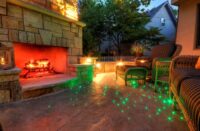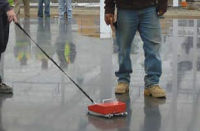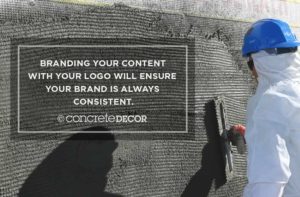I learned how to sell decorative concrete the summer of 1984 while working for my grandfather’s concrete construction business. I was out of college for the summer and looking to earn money. I learned how to sell decorative concrete before I’d heard of reactive stains or concrete countertops. At the time, I had no idea that the summer of 1984 would provide me the decorative tools necessary to sustain a career within the decorative concrete industry.
One particular Saturday afternoon changed forever how I approached customers, builders, and architects.
My grandfather convinced me to tag along on a sales call this particular day. Armed with nothing more than a pencil, pad, and tape measure, we listened to the woman describe her idea to remove a tiny slab of backyard concrete with hopes of turning the same area into something “entertainable.” My grandfather commented on her freshly painted home and then explained the need to carefully protect the walls while installing new concrete. He explained how the new patio would gently slope away from the home as well. He comfortably listened as the woman explained her intentions of providing an area large enough for two tables with room between.
In less than 20 minutes the conversation turned to a point discussing schedule, days to complete, and what salesman refer to as a “closing.”
While driving away from the job I noted to my grandfather that he sold the job without mentioning a price. He told me he would confirm price when he called to confirm schedule and a few other details. Then he said the one thing I have used to sell more than $30 million dollars in decorative concrete. He said, “I sold the job not by price but by simply connecting with the homeowner.”
The decorative concrete industry is driven by fascination. Inspiring this fascination in customers is only possible when you connect first and foremost. Unfortunately, this is the number one aspect I see missing within our talented artisans today. Just like your ability to create with color and concrete, there is an art to connecting with architects, designers and owners.
Many of you just returned from the Concrete Decor Show in San Antonio. You learned cutting-edge techniques from leading decorate experts. Now it’s time to put this worthwhile information to good use at a local level. How? Glad you asked.
The first step in connecting to your local market is 100 percent at no cost to you. Local media — newspapers, TV news shows, magazines — love to feature home improvement stories describing new colorful trends. The fact a local company can provide something of interest to a weekend viewer is a plus for you. Why not prepare a short press release or email your local editor explaining your decorative concrete experience in San Antonio? My company has benefited many times from doing just this each time we implemented a new decorative technique. You will be surprised in the interest you get from your local media. Now, let’s discuss how best to structure a short article describing something related to decorative concrete.
First, this is not about you. Of course, you will receive promotion and benefit, but the basis of the article must not be you or your decorative business. This is a common mistake most make.
Instead, think of what features connect your decorative techniques to the local home improvement market. Are they into sustainability or environmentally friendly practices? Is there a local market in concrete restoration? Can you promote vibrant colors or is the local flavor tending more toward earth tones? Connecting is about tapping into local tastes, needs, and expectations beyond yours.
I recall a young man with a very cool polishing machine who asked me to accompany him on a sales presentation. He was concerned why he was awarded so few jobs bid. It only took 10 minutes for me to see the problem. I watched him spend so much of his face time explaining the features of his machine, even to a complicated point. End users don’t care about features. They want nothing more than to see if your service provides a look to their taste and budget. Don’t overwhelm potential customers with technical stuff — this is the opposite of connecting.
Part of the connecting process is to understand your customer or decision-maker. Always approach an architect differently from the way you would a designer and a builder differently from the way you would a homeowner. Architects are more structurally oriented than designers. Designers love continuity and color flow. Builders have many things all happening simultaneously, so offer to relieve their stress by walking their client through the front-end portion of picking colors, surfaces and so on.
Remember, connecting is nothing more than understanding a person and then formatting your services to their needs. Feel free to email me for more specific connecting techniques formatted to your business.
















